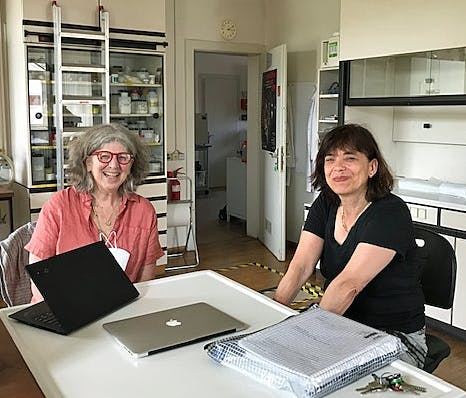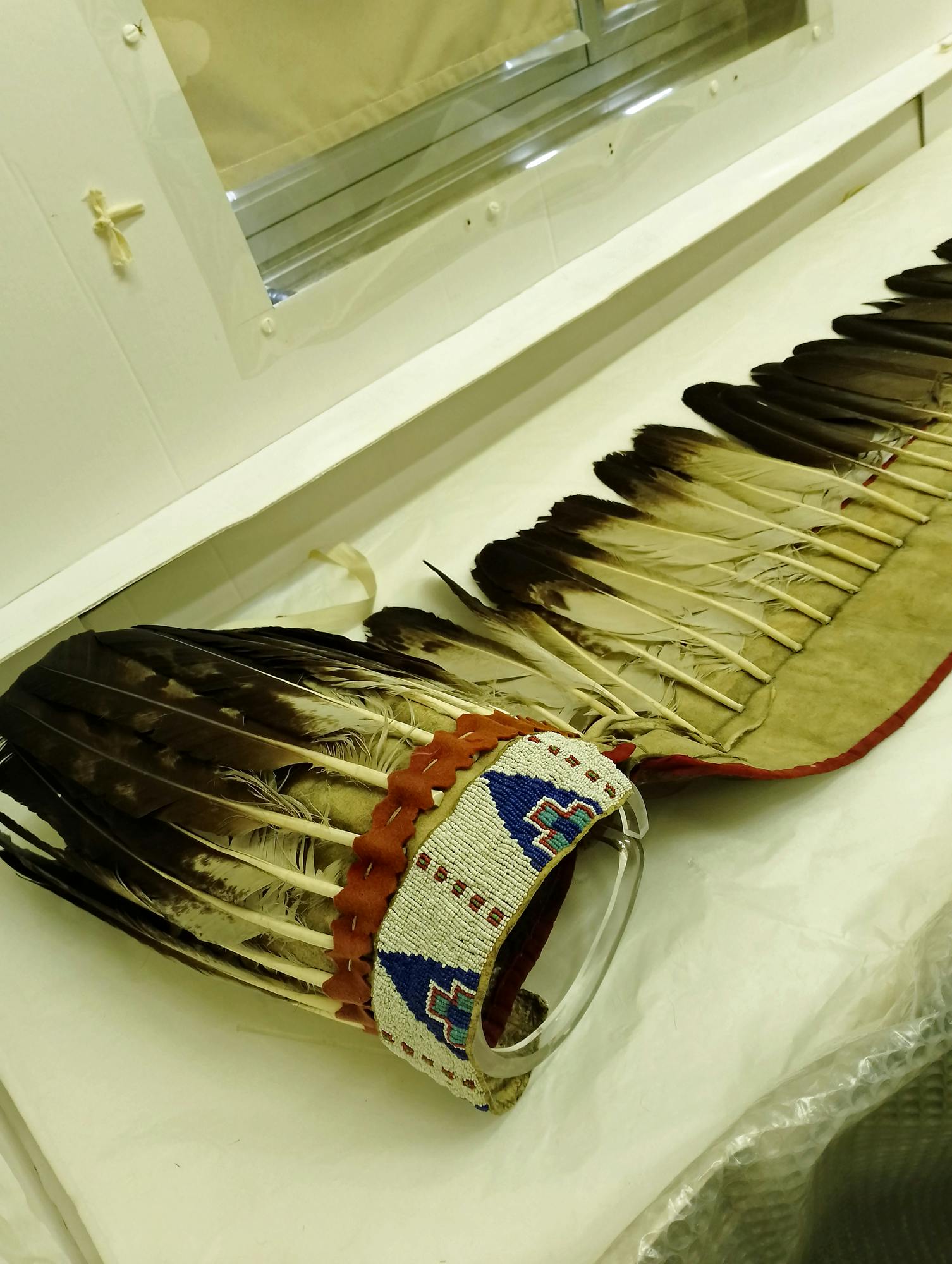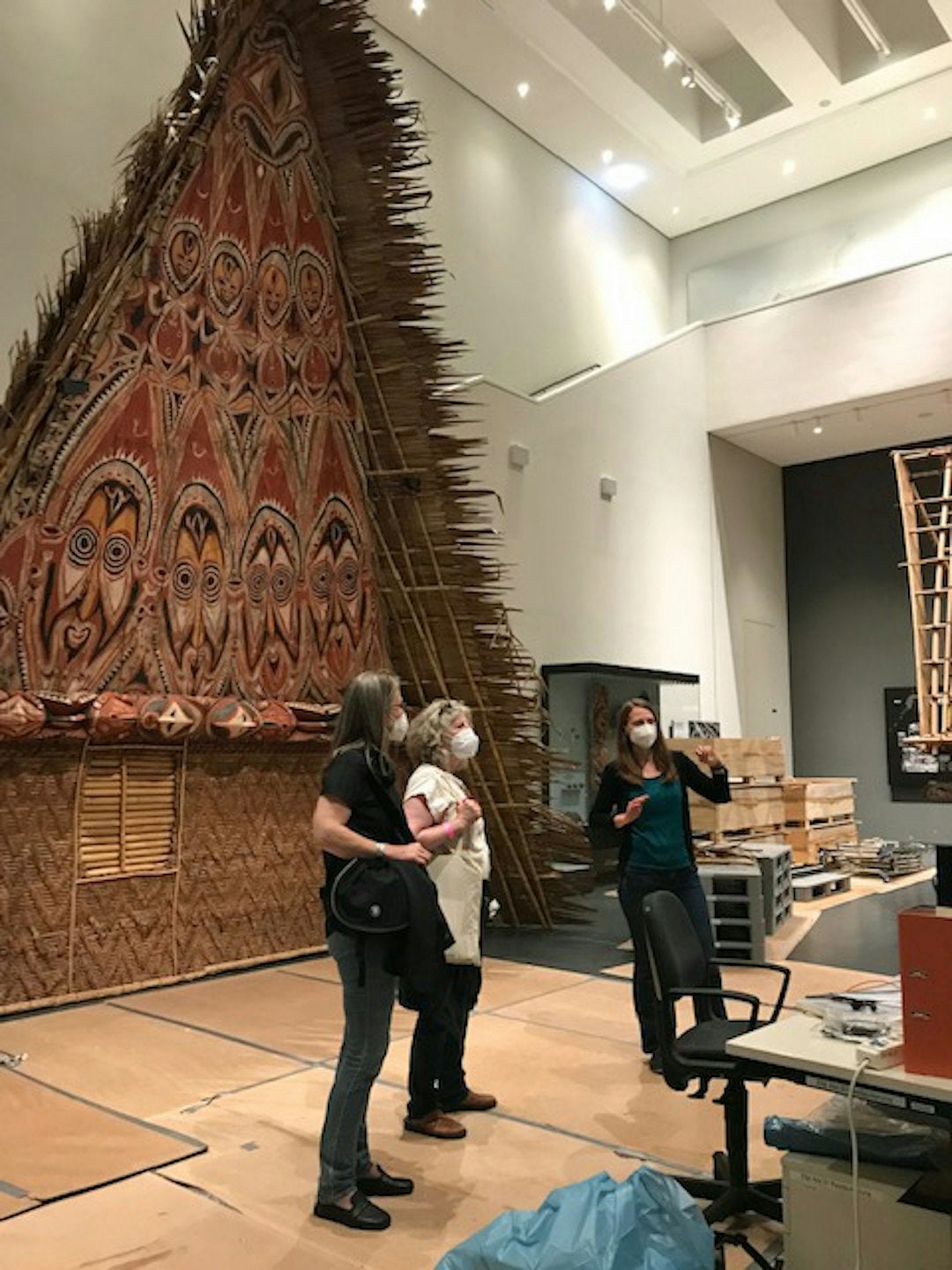UCLA/Getty Conservation Scholar bridges the gap between Indigenous artifacts and the people they represent through respectful conservation practices.
As one of three national awardees of the Suzanne Deal Booth Rome Prize Fellowship for Historic Preservation and Conservation from the American Academy, Ellen Pearlstein spent six months in Italy this year, working on her proposed project, “Conservation consultation around Indigenous American materials— the view from Europe.” The UCLA professor of information studies and UCLA/Getty Conservation had the opportunity to explore two major ethnological museums in the Vatican City and in Rome, as well as institutions in Paris, Vienna, and cities throughout Germany.
While in Europe, Pearlstein conducted research on how museums that have been historically detached from the communities whose cultures they exhibit find ways to access these communities through culturally appropriate museum practices. One highlight of her research was connecting conservators at the Vatican Ethnological Museum with Chuna McIntyre, a Yup’ik elder from a community in Alaska, through a virtual meeting. Together, the group discussed the most appropriate ways to label and display Yup’ik masks in the museum’s collection.

Professor Pearlstein serves as principal investigator for a project that aims to increase diversity in the conservation field, supported by the Mellon Foundation. This project invites students from the University of California and the California State University, as well as institutions across the country with large populations of underrepresented students, including the Institute for Indian Arts in Santa Fe, New Mexico, and Fort Lewis College in Durango, Colorado, to participate in a bootcamp workshop followed up by internships preparing them for graduate study.
In 2009, Pearlstein was honored with the Sheldon and Caroline Keck Award for distinguished teaching and mentoring from the American Institute for Conservation (AIC). She is a fellow of both AIC and the International Institute for Conservation.
Pearlstein has edited a forthcoming book on international changes and transformations in the conservation of indigenous cultural heritage, to be published in 2024 as part of the prestigious Getty Readings in Conservation series, published by the Getty Conservation Institute. Pearlstein, McIntyre, and Stefania Pandozy, have a paper in review on “Central Yup’ik masks in the Vatican City; Indigenous American Heritage in European Museums,” written for the journal, Museum Management and Curatorship. In addition, Pearlstein and McIntyre are preparing an upcoming article on, “Traditional and conservation interpretations of pre- and post-collection working methods for Yup’ik masks,” for the Journal of the Institute of Conservation.
Professor Pearlstein will present a UCLA/Getty Conservation Conversation with McIntyre on Friday, Oct. 28, at 11 a.m., PST. To attend this event, register with Eventbrite. Here in The Latest, she shares her experiences in European museums and her exploration of culturally responsible and respectful conservation practices in the wake of postcolonialism.
How did your Rome Prize project reinforce your thinking about the stewardship of Indigenous American materials in European museums?
I developed relationships with two museums in Italy, one of which is in Vatican City, the Ethnological Museum Missionary Museum that’s part of the Vatican Museums. It goes now by the name of Anima Mundi, which means “soul of the world.” And the second museum I worked with is in Rome, the Luigi Pigorini Museum, named after the first major collector who assembled the collections.
I took advantage of being in Rome by spending time every week in those two museums and looking at collections there, interviewing people. I did also travel to Paris and Vienna and many cities throughout Germany and visited other museums, and interviewed a lot of people about collections, caretaking practices, and have some very interesting perspectives now about Europe, but in particular about Italy.
What is unique about American Indigenous collections in European museums?
Many of the collections assembled in Europe, are amongst the earliest that we know of. To take one example, when France had ownership of different parts of the United States like Louisiana and also parts of Canada, it was quite typical for these very early collections to be assembled. We’re talking about 17th and 18th century materials that were collected and documented. The reason that’s so unusual is that here in the United States, our museums started in the second half of the 19th century.
Collections started to be amassed at that time, and therefore our U.S. museums typically hold late 19th and predominantly 20th century collection material. We have a whole range of
cultural expressions, material use, and technologies, that have been impacted by all kinds of trade and migration… that are more prevalent in in our U.S. collections, whereas these collections held in Europe are frequently of extremely early date and represent a whole different timeframe.
What was most significant about the meeting between Chuna McIntyre and the conservators at the Vatican Ethnological Museum?
I discovered in the Vatican Ethnological Museum a number of masks from an indigenous community in Alaska. I identified an elder from that community, and was able to prepare documentation on all of these masks and send it to him electronically. And then, together we held a three-hour long meeting from the Vatican museums, where the curator, the conservators, and myself, all participated with this elder, looking at these masks, and learning about what they are most appropriately called in the indigenous language [and] what are the elements that we would expect to find on these, now missing through the vicissitudes of time.
Who is represented on these masks? What are the layers of meaning for these masks? And, what might be the most appropriate way [to display and label them], because these masks are going on exhibit in the Vatican museums. This elder was able to edit the label copy that’s going to be presented with these masks, really pointing out that [even though] these masks are non-Catholic, they are still highly spiritual. It just shifts the way in which a particular kind of museum would categorize these items in a way that’s much more profoundly connected to their original meanings.

Do you feel that the conservation of Indigenous materials in the United States is colored by our checkered history with Native American peoples, almost as if institutions are trying to pay cultural reparations? And how does it differ from the way the same materials are handled in Europe?
There is a certain social justice aspect to the way North American museums want to, as you say, make reparations to the very people whose lives we completely turned on their heads. And there is also a certain kind of guilt that is very much part of the attitude. This is not always held by European countries because their period of colonization within the United States or Canada was not continuous across time. They maintained colonies [and then] gave up those colonies.
However, the collections were already in hand. The collections might have been procured in exactly the same way [as] the United States … in a way that was injurious to the to the very people who they were collecting from. One could argue that the Vatican had missions and missionary work all over the indigenous United States, and they were both providing certain kinds of services [such as] teaching about religion. The U.S. federal government contracted with the with the the Roman Catholic Church to actually run schools for the indigenous communities.
A difficult thing is that the “Indianness” was being extracted, and European methods were being reinforced. In some cases, people were no longer allowed to make their own indigenous regalia or materials. Nonetheless, there were a lot of missionaries who collected these materials when they encountered them. They recognized them as different or beautiful, or prohibited … but they would collect them.
And there also were young native American students who were in a missionary or missionizing environment, who would ostensibly give gifts to the Church, and those gifts would sometimes be this very traditional regalia that has now ended up in [the Vatican] museum. One could conjecture about coercion and we know about it very transparently now, in our U.S. institutions, that things were procured or collected under not very ethical ways exactly. We know that. [These discussions are] certainly happening in Europe.
[Today], our tendency is toward working very directly with the very communities whose materials we hold, and recognizing that members of these communities can find revisiting these collections something of extraordinary value and import. They consider them [as] ancestors, they consider them family members.
They consider them technical feats, perhaps using methods that they no longer understand, for items they no longer know how to make. They may be wanting to resuscitate a technology, revitalize a technology that has been lost to them. They may want to use it in language revitalization. We have a lot of endangered languages, and sometimes that physical item is actually what the language refers to. So, there are all kinds of reasons why creating intersections between the community members with whom these items originated, and these collections held in museums all over the world … there are so many reasons why it’s beneficial to make these connections. Again, it helps indigenous people with a sense of pride and their history.
Some American Indian peoples are extremely proud that people all over the world see their early materials, but they want to see them themselves. And then, of course, you know, there are other people that want to have those materials be returned. We know that there is a full range of types of access that is important to communities, especially things that were taken unethically or illegitimately, or were never given with full rights, I mean, stolen.

Are there large or even small indigenous American communities anywhere in Europe?
It was interesting. I tried very hard to research that. I don’t think any of the diaspora communities are very large, or very organized, but I think they exist. They’re just not readily found. I followed a whole group of leads.
I would say within Italy, no, but I think within parts of Germany, there have been diaspora communities. In the United States, in the late 1800s, or maybe even earlier, there was a development of something called Wild West shows. They were costumed performances and they illustrated cowboys and Indians, the American West. They traveled around the United States so that people in New York could find out about the Wild West, and they also traveled all over Europe.
I read these stories of indigenous Americans who were hired to wear traditional regalia and perform in these Wild West shows, and they were very beloved in Germany. There was an entire cult [following] in Germany that many people recall growing up with. They read these fictional books about American Indians. And I think that these Wild West shows actually brought American Indians to Europe who then stayed on.
There were also American Indians who signed up to fight in World War II on the side of the United States, and they ended up on battlegrounds in Italy and Germany. For example, I found that when I went to a publicly available listing of a military cemetery dating back to World War II, if I would look to the various Italian sites for these cemeteries, there were recognizable [American] indigenous names. But again, I don’t think those people made their families there, or if they did, it’s really difficult to find them.
What are some recent examples of scholarly work that you and your students have done on Indigenous collections in Europe?
At the Pigorini Museum, there is an American Indian eagle feather war bonnet headdress, [one of] these headdresses that are very familiar to many people. They have long trailers of eagle feathers, and many people associate them iconically with American Indians. There is one of these items in the collection of the Pigorini with very poor historical records, it’s uncertain as to where exactly it came from.
A conservation student at a very prestigious center in Rome did his thesis research on this particular headdress, and it prompted me to think about the fact that one of our own UCLA/Getty graduate students had also done her thesis on a headdress of questionable provenance [with] very similar material make-up. So, I’m engaging in writing a paper with an Italian conservator, and my former graduate student, looking at the way, a very similar item held in two very distinct parts of the world… how that conservation process proceeds.
A student who learns their field of study at UCLA and a student who learns their field of study in Italy… those respective relationships to American Indian materials are quite different. That’s another thing about the view from Europe, it’s another part of that larger project. I also have a visiting scholar at UCLA who is the head of conservation in a French museum with very diverse collection holdings of non-European background, and she and I are looking very closely at how the French relate to having indigenous American materials in their holdings.
So, I would say the time in Rome has been very generative, because I’m now connecting with other people and places in Europe. I’ve got [the] very, very early stages of a book proposal where we would have authorship from representatives from many different European countries, talking about the the ramifications of reaching out to the Americas from their particular locale, because there are legal, social, and cultural reasons why we in the United States work with our own indigenous communities the way that we do, and it’s only when you look at a contrast with other places that you actually really understand the way we do our work.
